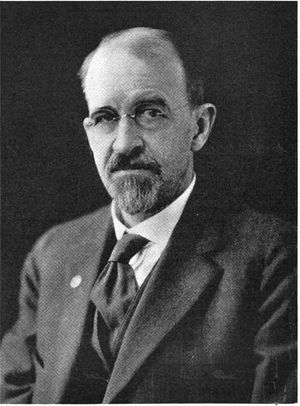Edward M. Hewlett
- Birthdate
- 1866/09/14
- Birthplace
- Cold Spring Harbor, NY, USA
- Death date
- 1934/05/24
- Associated organizations
- General Electric (GE)
- Fields of study
- Switching
Biography
Edward Marriott Hewlett was born in Cold Spring Harbor, NY, the son of Edward Townsend Hewlett and Eliza M. Hewlett on September 14th, 1866. Hewlett was initially employed as manager of the Cascade Town Improvement Company in Colorado, where he surveyed the first road up Pike's Peak, and constructed the first winding carriage road to the top.
He began work in the electrical industry in 1890 by taking the expert course offered by the Thomson-Houston Company at Lynn, MA, and assisted with the installation of lighting on the Statue of Liberty, particularly the first focusing lamps in the torch, and a row of lamps under the rim of the liberty cap.
After the General Electric Company was formed from the merger between Edison General Electric Company and the Thomson-Houston Company in 1893, Hewlett returned to the Lynn factory as assistant to the department head on switchboard controller work, doing development work on switchboards, magnetic blowout circuit breakers, and other magnetic blowout devices. Later, he developed insulators for third-rail railway work and for underground trolley rails running in slots which previously were required in connection with cable street-car systems. He also developed the underground contact plow. Hewlett developed a type of oil circuit breaker with a high interrupting capacity for use in the main station of the Metropolitan Street Railway Company, New York. The success of this pioneer large-capacity installation gave an incentive to other companies. As power distribution developed and the voltage was increased step by step, it was necessary at each successive stage to study the possibilities of insulators, insulating materials and so forth for the bushings for oil switches and for supporting disconnecting switches and busbars. During this period, Hewlett developed switches and switching equipment to meet each new requirement.
Hewlett designed the control switchboards for the Panama Canal. This installation was particularly adapted to naval use and made possible the control of the machinery from a distant control point, something that had not heretofore been done. During the war, he was chief consulting engineer of the naval experimental station at New London.
With Harold Buck, Hewlett was the inventor of the Hewlett suspension disc insulator in 1907, which was widely used for decades.
Hewlett was a Fellow of the American Institute of Electrical Engineers. Hewlett died on May 24th, 1934.
